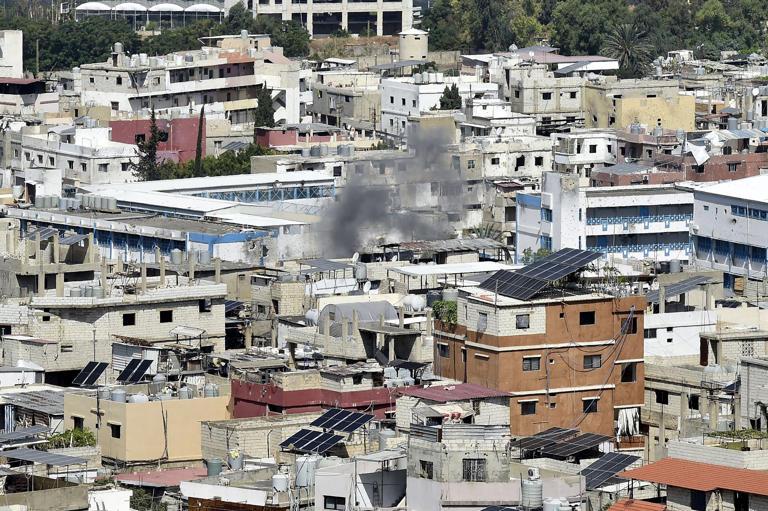
How Hamas gains from Fatah’s fight
Residents of Lebanon’s largest Palestinian refugee camp are stuck in a cycle of conflict.
Since late July, Ain Al Hilweh has been rocked by on-and-off clashes between Fatah, the dominant faction in the camp, and hardline Islamist militants.
The latest uneasy ceasefire was announced last week and is currently holding, but previous ceasefires failed to stop fighting that has killed at least 31 people and displaced thousands.
Fatah has demanded militants give up the killers of one of its senior commanders by the end of the month.
With no signs that militants will surrender, more clashes in the camp – and more misery for its 70,000 inhabitants – seem likely.
“The main power in the Lebanese camps is in the hands of Fatah, and any threats to the group is interpreted as an attempt to take away Fatah’s authority,” said Suheil Natour, a Beirut-based Palestinian analyst and member of the leftist Democratic Front for the Liberation of Palestine.
The challenge to the Fatah’s authority in the camp could also stand to benefit its political rival Hamas, the other prominent faction in Palestine and the camps. Fatah is the dominant party in the West Bank-based Palestinian Authority, while Hamas controls Gaza.
How did the clashes start?
The clashes began when a Fatah gunman attempted to assassinate a leader of the Al Qaeda-affiliated Jund Al Sham group, according to security sources within the camp.
The next day, Islamist militants killed Fatah security commander Abu Ashraf Al Armoushi and four bodyguards. Fatah retaliated with force and attempted to expel militant groups from the camp.
“When Al Armoushi was killed in this deliberate way, it constituted a public insult to their leadership as the leader of the Palestinian struggle for refugees,” said Mr Natour.
Fatah has conditioned a long-term truce upon the surrender of Mr Armoushi’s killers and the withdrawal of Islamist groups barricaded inside two UN compounds that host the camp’s schools.
Which militants is Fatah fighting?
Most of the street battles have pitted Fatah mostly against Jund Al Sham, the Shabab Al Muslim group, and their affiliates.
By long-standing convention, the Lebanese state does not have jurisdiction over Palestinian refugee camps, leaving residents to handle security.
In Ain Al Hilweh, radical Islamist groups like Jund Al Sham have exploited the lack of state oversight and loose internal security to establish their influence, which Fatah has been unable to subdue.
According to Fatah and Hamas officials, the groups are made up of Lebanese, Palestinians and Syrians, and are divided ideologically.
“These groups are not ideologically united and they’re extremely limited in size – less than a hundred people,” said Ayman Shanaa, the Hamas representative for Saida.
What role is Hamas playing?
Hamas’s status as a relatively moderate Islamist party has allowed it to play a mediating role between hardline militants and Fatah.
Publicly, Hamas has backed Fatah’s demands for the surrender of Mr Armoushi’s killers and the dismantling of hardline groups.
“If we are able to achieve a lasting ceasefire, and if we present a united and strategic Palestinian front, we would be able to dismantle these groups and prevent them from establishing a permanent role in Ain Al Hilweh,” Hamas’s Mr Shanaa said.
But some in Fatah – including senior official Azzam Al Ahmad, a member of the group’s central committee – have accused Hamas of playing a role in the fighting, which Hamas denies.
But for analyst Suheil Natour, “The big question is: where do they [hardline Islamists] get powerful ammunition to supply them for battles? Where do they get funding?”
“This is not possible unless one or more of the larger Islamic organisations are behind it.”
Hamas is strategically seeking a greater role in Ain Al Hilweh to expand its influence at Fatah’s expense, he said.
The strategy may already be working.
Meetings between Fatah and Hamas to discuss the clashes seem to have given Hamas a larger role in administering security in Ain Al Hilweh, which was traditionally primarily the job of Fatah’s National Security Forces.
Now, both parties have pledged to strengthen a pre-existing Joint Force, comprising the camp’s varying Palestinian factions including both Hamas and Fatah, to enforce camp security.
Fatah faces a lose-lose situation, said Mr Natour.
“Fatah loses either way. They lose popular support if they don’t get [Islamist surrender]. And they lose if the battle continues. In every scenario, Fatah loses,” he said.
Residents sick of politics
Both Lebanese and Fatah leaders have threatened the possibility of army intervention, which could worsen conditions in the overcrowded and poverty-stricken camp and destabilise Lebanon itself.
A camp resident, speaking under condition of anonymity due to his position as a member of Ain Al Hilweh’s governing Popular Committees, said he was disgusted by the fighting and the factions.
“Is this rivalry worth destroying the camp?” he asked. “They wont give us any choice besides displacement or death. Why are those always the only options for Palestinians?”
For over seven decades Lebanon’s refugee camps have sheltered Palestinians forcibly expelled from their land during what they refer to as the Nakba, or catastrophe, which saw the creation of Israel in 1948.
“Frankly, the people of Ain al Hilweh are sick of both Fatah and the Islamists,” Mr Natour said. “Because the violence is being levelled at the residents, instead of at Israel.”
Source » gulfnews





